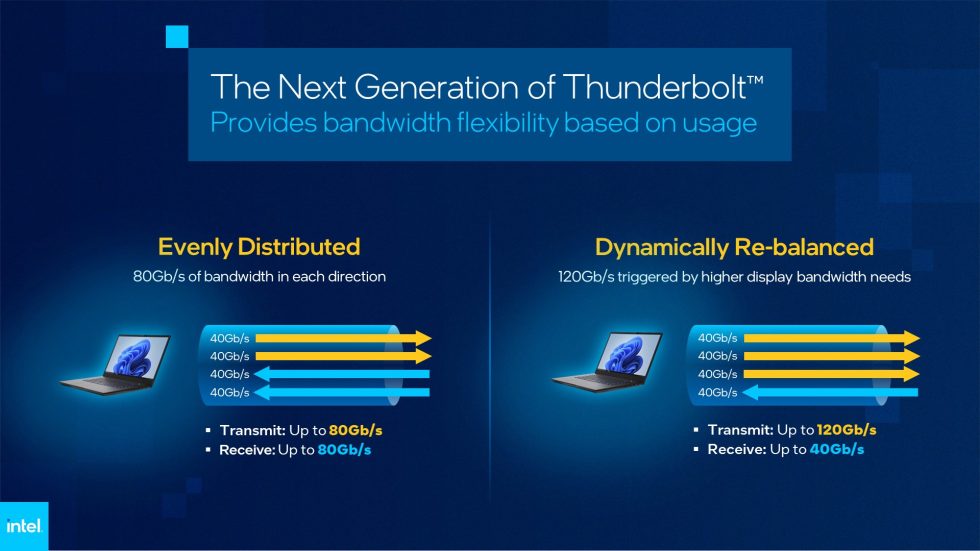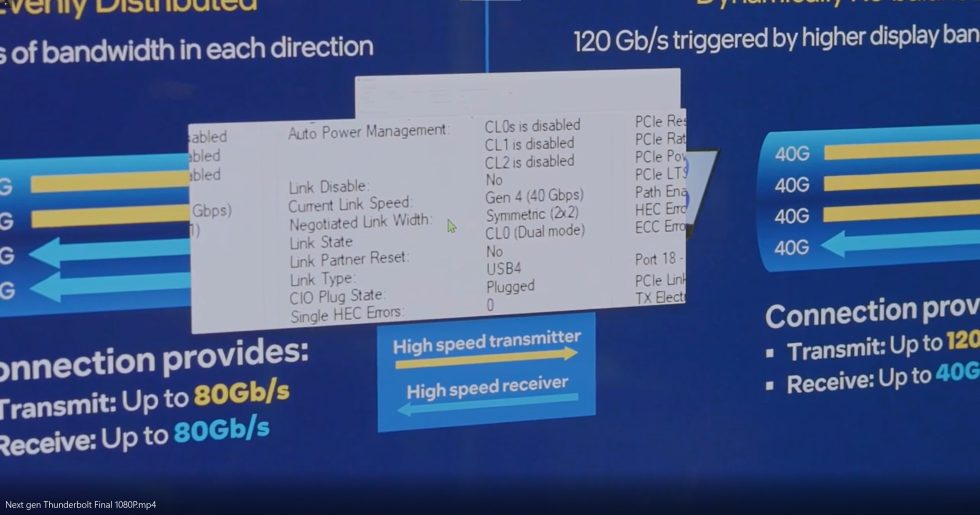Intel announced further details about the next generation of Thunderbolt today. The company wouldn't commit to a name for the upcoming specification or a release date for what we hope will be called, simply, Thunderbolt 5. However, we do know that the next Thunderbolt will support up to 80Gbps bidirectional bandwidth and be able to transmit data at up to 120Gbps.
Will it be called Thunderbolt 5? Hopefully
In a meeting with the press, Jason Ziller, general manager of the Client Connectivity Division at Intel, said the next version of Thunderbolt isn't named yet. However, he noted that Intel has typically taken a simple approach to Thunderbolt naming.
Ziller acknowledged that the USB-IF's naming scheme for USB specifications is "very confusing." The USB-IF yesterday published the unfortunately named USB4 Version 2.0 spec and, more recently, ditched its recommended SuperSpeed branding for consumers in favor of performance-based names like USB 40Gbps.
"[Users] don't need to have [features] built into the name or a fancy logo on the side of a notebook, where you can't even see it anyway," Ziller said.
That said, there's hope for a logically sound name for the upcoming spec, like Thunderbolt 5.
120Gbps operation
Unlike with the move from Thunderbolt 3 to Thunderbolt 4, Intel's giving the next generation of Thunderbolt potential for a big jump in speed—but there's a catch.
Whatever it's called, next-generation Thunderbolt will be able to transmit data out across three lanes at 40Gbps each, for a total of 120Gbps. Simultaneously, the port will be able to receive data at up to 40Gbps, Intel says, for other devices, like an external SSD. This differs from Thunderbolt 4, which operates at up to 40Gbps in either direction using a total of four lanes. This is similar to USB4 Version 2.0 spec, except 120Gbps is optional with the USB-IF's spec.
This 120Gbps mode, so to speak, will only activate when a high-performance display is connected. In normal use, though, the next Thunderbolt will operate at up to 80Gbps in either direction (still twice the rate of Thunderbolt 4), with two lanes for transmitting data and two lanes for receiving data.

According to Ziller, the next Thunderbolt will automatically switch from 80/80Gbps operation to 120/40Gbps when connected to a display requiring more than 80Gbps. Intel is still working out how that automatic switching works but sees the next-gen spec supporting things like 8K HDR monitors, 10-bit HDR color, dual 480 Hz monitors, or a 4K monitor at 240 Hz.
Once Thunderbolt has been switched into 120Gbps mode, a pipe transmitting data out can handle more than just video, such as storage data, for example. But only a bandwidth-hungry display can activate the mode, because "that's really the most important thing that's gonna have very high bandwidth needs that are only going in one direction," Ziller said, noting the typically bidirectional nature of storage. And like with Thunderbolt 4, displays will get priority over other types of devices with next-gen Thunderbolt.

Intel also shared a brief pre-recorded video demoing early prototype silicon with the new tech using 80Gbps bidirectional bandwidth. The system was reportedly connected to an 8K resolution display and an external SSD.
More speed for external storage and graphics
Like with Thunderbolt 4 (and unlike with USB4), PCIe tunneling support is mandatory for the next generation of Thunderbolt, which will also double PCIe data throughput from Thunderbolt 4's 32Gbps to 64Gbps.
This should enable faster storage, particularly in extreme needs, like when moving large amounts of data back and forth between an external SSD. It could also improve performance in devices like external graphics cards (eGPUs) and video capture cards.
But don't get too excited yet. Next-gen Thunderbolt products are likely months to years away, but product releases with PCIe-related technologies could be even slower. Today, Thunderbolt 4-based SSDs, eGPUs, and video-capture cards still aren't readily available.
Next-gen Thunderbolt cables
Thanks to a new "signaling technology," the next version of Thunderbolt will be backward-compatible with previous generations of Thunderbolt, USB, and DisplayPort, Ziller said. Further, Thunderbolt cables you already own may support the new protocol.
Thunderbolt's next generation will work with the same passive Thunderbolt 4 cables available today, as long as they're not longer than 3.3 feet (1 meter). For longer distances, you'll need new cables, for which the spec isn't yet defined.



3175x175(CURRENT).thumb.jpg.b05acc060982b36f5891ba728e6d953c.jpg)

Recommended Comments
There are no comments to display.
Join the conversation
You can post now and register later. If you have an account, sign in now to post with your account.
Note: Your post will require moderator approval before it will be visible.